
Showing posts with label energy. Show all posts
Showing posts with label energy. Show all posts
Wednesday, August 15, 2012
Fusion power
There's one important source that I did not cover in my recent series on energy, because it has not yet proven to be commercially viable, is nuclear fusion. Fusion is the process that occurs in stars. As small atomic nuclei fuse together to make heavier nuclei, energy is produced. Nuclear fusion could prove to be an incredible source of energy, since the fuel source, hydrogen, would be readily available from ocean water, and the byproduct, helium, is environmentally benign. Unfortunately, it has so far been difficult to contain and perpetuate the fusion reaction process. One important step in bringing the promise of fusion to fruition is the ITER reactor being built as an international cooperative project in France. So far, though, this project has run into technological, budgetary, and bureaucratic problems, as described in a recent Scientific American article. That article was illustrated with a LEGO model of the ITER reactor by Sachiko Akinaga, and the Scientific American blog has more photos.


Tuesday, August 7, 2012
Solar power
All of the electricity generation discussed so far has involved turbines. Either water is heated (by burning fuel or from nuclear fission) to make steam, that turns turbines, or wind, water or waves turn the turbines directly. Solar power works on a completely different principle. In the photovoltaic effect, absorbance of light energy causes some substances to emit electrons. In a solar cell, this movement of electricity is captured as an electric current. Unfortunately, while this has great potential as a renewable resource, it is still not used very much. A couple of years ago solar accounted for 1% of US electricity and estimates suggest this will rise to 4% by 2020. Many LEGO creations, particularly futuristic ones, feature solar panels, such as Annie Corder's city,

Doctor Sinister's Aurora Station,
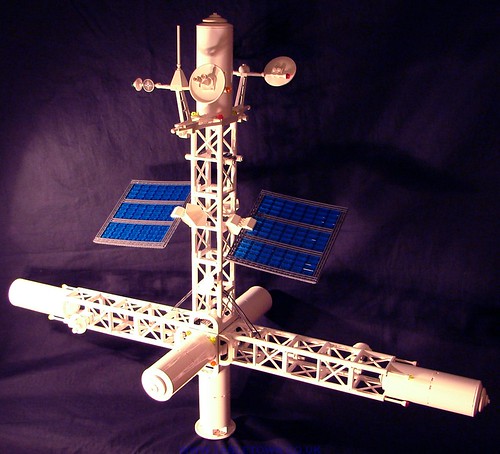
and Zg1134's WALL-E.

Here's a solar power installation from Legoland Billund.

LEGO has even made two official real solar cell elements that are used in a few of the educational Dacta sets.

Here Peter Hoh used one of them to make a solar-powered car.
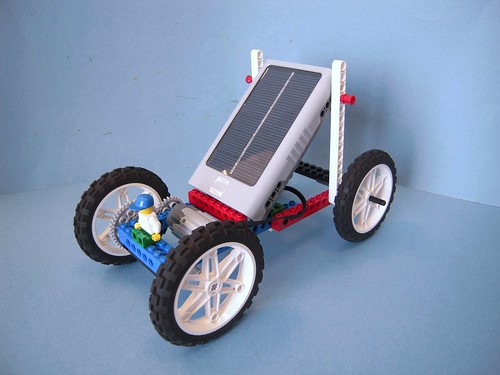
And that's it for our little foray into understanding how electricity is produced. I'll go back tomorrow to a series of more random MOCs that have popped up recently.

Doctor Sinister's Aurora Station,

and Zg1134's WALL-E.

Here's a solar power installation from Legoland Billund.

LEGO has even made two official real solar cell elements that are used in a few of the educational Dacta sets.

Here Peter Hoh used one of them to make a solar-powered car.

And that's it for our little foray into understanding how electricity is produced. I'll go back tomorrow to a series of more random MOCs that have popped up recently.
Sunday, August 5, 2012
LEGO and wind power
LEGO has an extensive record with wind power. In their educational Dacta line, sets like 9684, Renewable Energy and 9688, Renewable Energy Add-On help kids create science experiments to learn about wind power.

In 2008 they created an exclusive set, Vestas Wind Turbine as part of their cooperation with that company (see yesterday's post). Unfortunately for LEGO fans, that set was very limited, and only available to Vestas employees.

Probably in response to the huge AFOL interest in the exclusive Vestas set, the following year LEGO released 7747, Wind Turbine Transport.

Wind turbines have also been featured in the Legoland parks, such as here in Billund.

A larger wind farm is being built at Legoland Billund, to celebrate LEGO's billion kroner investment in a wind farm being built off the coast of Germany. The company is committed to using 100% renewable energy by 2020.

In 2008 they created an exclusive set, Vestas Wind Turbine as part of their cooperation with that company (see yesterday's post). Unfortunately for LEGO fans, that set was very limited, and only available to Vestas employees.

Probably in response to the huge AFOL interest in the exclusive Vestas set, the following year LEGO released 7747, Wind Turbine Transport.

Wind turbines have also been featured in the Legoland parks, such as here in Billund.

A larger wind farm is being built at Legoland Billund, to celebrate LEGO's billion kroner investment in a wind farm being built off the coast of Germany. The company is committed to using 100% renewable energy by 2020.
Saturday, August 4, 2012
Vestas Display
In 2009 LEGO partnered with the Danish wind power company Vestas to create a big public display that was in the Stockholm airport. I do not know if it is still there or if it was ever displayed at other locations. The different display boxes showed wind turbines being constructed and used all around the world. There was also a large house showing all the ways we use electricity, a free build section, and a giant turbine.












Friday, August 3, 2012
Wind energy
Windmills have been used for the past 2000 years to harness the energy of the wind to mill grain and pump water (MOCs by Darthtuner and MdrnMrvls, respectively).


In more recent years, wind power has been used to generate electricity. The idea is quite simple: wind turns the blades of the windmill, which spins a turbine, which generates electricity. Wind power generation is very efficient and completely renewable, though there is a large capital investment to build wind farms. Currently wind supplies about 4% of electricity used in the US, though proponents say that it could supply up to 20% by the year 2030. Several LEGO builders have made turbines, such as this micro version by Pbpancho,

this minifig scale installation by Matija,

and a three meter high version by Engineers Without Borders.

Here's a great MOC of a turbine transport by Marek Markiewicz.



In more recent years, wind power has been used to generate electricity. The idea is quite simple: wind turns the blades of the windmill, which spins a turbine, which generates electricity. Wind power generation is very efficient and completely renewable, though there is a large capital investment to build wind farms. Currently wind supplies about 4% of electricity used in the US, though proponents say that it could supply up to 20% by the year 2030. Several LEGO builders have made turbines, such as this micro version by Pbpancho,

this minifig scale installation by Matija,

and a three meter high version by Engineers Without Borders.

Here's a great MOC of a turbine transport by Marek Markiewicz.

Wednesday, August 1, 2012
Geothermal energy
Another way of generating electricity relies on the heat energy of the core of the earth. The earth's core reaches temperatures of up to 5000 degrees Celsius. This is in part left over heat from the origin of the planet, but is even more due to the decay of radioactive elements deep in the earth's core. This tremendous heat energy melts rock, which begins to rise. Most spectacularly, if this magma bursts through to the earth's surface, we see a volcano (here in LEGO by Bryce McGlone and Brandon Griffith).

If the magma does not burst through to the surface, but instead heats up groundwater, the resulting superheated steam can burst out in the form of a geyser (here in LEGO by Brother Steven).
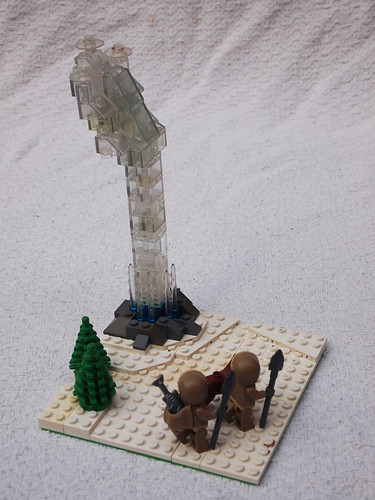
Geothermal power takes advantage of this superheated groundwater. Either the steam that is created directly turns a turbine, or its heat is used to vaporize a secondary liquid that then turns a turbine. In either case, this then generates electricity. MyGreenHosting made 'a LEGO set we'd like to see': geothermal powered data center. MyGreenHosting is an Icelandic web hosting company that promotes itself as environmentally friendly because they are completely powered by geothermal and hydroelectric energy.

Geothermal electricity is efficient and nonpolluting. Unfortunately, it is very limited in application because it requires very specific geological conditions. For instance, it only accounts for 0.3% of US power. Iceland is the Saudi Arabia of geothermal, with 30% of their electricity coming from geothermal. The Phillipines, El Salvador, Costa Rica, Kenya, Nicaragua and New Zealand are other countries with at least 10% of their electricity coming from geothermal.

If the magma does not burst through to the surface, but instead heats up groundwater, the resulting superheated steam can burst out in the form of a geyser (here in LEGO by Brother Steven).

Geothermal power takes advantage of this superheated groundwater. Either the steam that is created directly turns a turbine, or its heat is used to vaporize a secondary liquid that then turns a turbine. In either case, this then generates electricity. MyGreenHosting made 'a LEGO set we'd like to see': geothermal powered data center. MyGreenHosting is an Icelandic web hosting company that promotes itself as environmentally friendly because they are completely powered by geothermal and hydroelectric energy.

Geothermal electricity is efficient and nonpolluting. Unfortunately, it is very limited in application because it requires very specific geological conditions. For instance, it only accounts for 0.3% of US power. Iceland is the Saudi Arabia of geothermal, with 30% of their electricity coming from geothermal. The Phillipines, El Salvador, Costa Rica, Kenya, Nicaragua and New Zealand are other countries with at least 10% of their electricity coming from geothermal.
Monday, July 30, 2012
How Woody Guthrie won the war
I teach at a liberal arts college, and I really do believe in the liberal arts ideal. That is, a well rounded education includes an understanding of all different areas of scholarship. No subject can be treated in isolation. For instance, take something as simple as stopping at a McDonalds to buy a burger. This touches on health, which includes biology and biochemistry, to really understand what that burger is doing in your body. It also relates to economics, how large franchises such as this affect our economy. Environmental and ethical concerns can be addressed in how the food was raised to make that burger. History and sociology come in when you look at how the fast food industry helped drive (pun intended) the car culture of America. Psychology can look into how advertising helps mold the decisions we make. And that's just lunch. As you move through the day, all of the different academic pursuits give insight into everything you do.
So why bring this up in the present context? I love teaching my students about the applications of oxidation/reduction chemistry. This refers to chemical transformations that involve moving around electrons. For instance this tells us how batteries work to produce a flow of electrons. In an electrolytic cell, a flow of electrons is used to drive some chemical reaction. One example of this is the smelting of aluminum. Aluminum ore exists as an oxide, Al2O3. In this compound, aluminum has a charge of +3. On the other hand, pure aluminum metal has a charge of 0. How do you go from +3 to 0? You add three negatively charged electrons. For some LEGO, here are aluminum bricks by Bram Lambrecht (and, yes, they do fit together with real LEGO bricks).

This process of producing pure aluminum metal, though, requires a lot of electricity. This brings us to the 1920's and 30's. The Army Corp of Engineers and Bureau of Land Reclamation were in the process of building a large number of dams as public works projects. This was in large part driven by FDR and the desire to create jobs during the Great Depression. One proposed dam was the Grand Coulee Dam on the Columbia River. Here's a song commissioned by Woody Guthrie to help promote federal dam projects and the BPA:
Dams could be justified economically by their ability to provide water for drinking and irrigation and also electricity. The problem was, at the time there was not a large enough population in the Pacific northwest to really require as much electricity as would be generated by this new hydroelectric dam. Here's a MOC of the Pitlochry Power Station in Scotland by Bricklove (I could swear I've seen a microscale version of the Grand Coulee Dam before, but now I can't find it, so this will do).

This opened the door to create new customers, including aluminum smelters. And what industry (aside from soda cans) most needed that aluminum? The then-growing aeronautics industry, of course. What major company is based in Seattle? Okay, yes, Starbucks, but also Boeing. There's a reason that they are based there - that's where the power and aluminum was. This growing productive capacity in the late 30's was key to the US war effort in the following decade. Quite frankly, the Axis had the rest of us on the ropes in the early years of WWII, aside from the heroic defense of Britain and the snows of Russia. But the US was relatively safe behind two oceans, and the industrial capacity fueled, in part, by hydroelectric power, helped create the weapons to beat back the forces of Germany and Japan. Here are MOCs of two of the Boeing planes that were so important in WWII, the B-17 Flying Fortress B-29 Superfortress by Orion Pax and Junlego, respectively. The B-17 was key in defeating the Germans, and the B-29 helped end the war over Japan.


There you have it, how Arlo Guthrie won the war. With a little help from electrochemistry and hydroelectric power.
So why bring this up in the present context? I love teaching my students about the applications of oxidation/reduction chemistry. This refers to chemical transformations that involve moving around electrons. For instance this tells us how batteries work to produce a flow of electrons. In an electrolytic cell, a flow of electrons is used to drive some chemical reaction. One example of this is the smelting of aluminum. Aluminum ore exists as an oxide, Al2O3. In this compound, aluminum has a charge of +3. On the other hand, pure aluminum metal has a charge of 0. How do you go from +3 to 0? You add three negatively charged electrons. For some LEGO, here are aluminum bricks by Bram Lambrecht (and, yes, they do fit together with real LEGO bricks).

This process of producing pure aluminum metal, though, requires a lot of electricity. This brings us to the 1920's and 30's. The Army Corp of Engineers and Bureau of Land Reclamation were in the process of building a large number of dams as public works projects. This was in large part driven by FDR and the desire to create jobs during the Great Depression. One proposed dam was the Grand Coulee Dam on the Columbia River. Here's a song commissioned by Woody Guthrie to help promote federal dam projects and the BPA:
Dams could be justified economically by their ability to provide water for drinking and irrigation and also electricity. The problem was, at the time there was not a large enough population in the Pacific northwest to really require as much electricity as would be generated by this new hydroelectric dam. Here's a MOC of the Pitlochry Power Station in Scotland by Bricklove (I could swear I've seen a microscale version of the Grand Coulee Dam before, but now I can't find it, so this will do).

This opened the door to create new customers, including aluminum smelters. And what industry (aside from soda cans) most needed that aluminum? The then-growing aeronautics industry, of course. What major company is based in Seattle? Okay, yes, Starbucks, but also Boeing. There's a reason that they are based there - that's where the power and aluminum was. This growing productive capacity in the late 30's was key to the US war effort in the following decade. Quite frankly, the Axis had the rest of us on the ropes in the early years of WWII, aside from the heroic defense of Britain and the snows of Russia. But the US was relatively safe behind two oceans, and the industrial capacity fueled, in part, by hydroelectric power, helped create the weapons to beat back the forces of Germany and Japan. Here are MOCs of two of the Boeing planes that were so important in WWII, the B-17 Flying Fortress B-29 Superfortress by Orion Pax and Junlego, respectively. The B-17 was key in defeating the Germans, and the B-29 helped end the war over Japan.


There you have it, how Arlo Guthrie won the war. With a little help from electrochemistry and hydroelectric power.
Thursday, July 26, 2012
Hydroelectric dam
Most electricity generation comes from heating water to make steam which turns a turbine. In the US this heat is mostly from the burning fossil of fuels (69% of electricity generation) and secondarily from nuclear fission (20%) (2009 statistics). In France, nuclear energy forms the bulk of electricity generation (78%) (2006 data). The next most important form of electricity generation is hydroelectric power (7% in the US, 11% in France).
The basic idea goes back two thousand years - using the movement of water to turn a wheel and then putting that turning to some use like grinding grain or sawing lumber. Here's a grain mill by Jojo.

Dams improve the efficiency of using water power. They do this in two ways. First, by storing up water they help even out the flow during rainy versus dry seasons. Also, by funneling the flow of water through a much narrower opening, they result in a much faster flow past the water wheel. Dams have other benefits, such as controlling flooding, acting as a reservoir for drinking or irrigation water, and even providing for recreational use. They also have downsides, in that they have a large impact on river ecosystems, for instance interfering with the migratory patterns of salmon or flooding areas (e.g. Hetch Hetchy Valley). Also, over time, dams can clog up with silt, either leading to their loss of usefulness or the need for difficult dredging programs. Here's a hydroelectric dam by Paul Janssen.

In a hydroelectric dam, the water is sent through a large pipe called the penstock, and it goes rushing through the turbines, which spin to generate electricity. Here's a power station by Peachtree.

Here's a clever ad for LEGO.

The basic idea goes back two thousand years - using the movement of water to turn a wheel and then putting that turning to some use like grinding grain or sawing lumber. Here's a grain mill by Jojo.

Dams improve the efficiency of using water power. They do this in two ways. First, by storing up water they help even out the flow during rainy versus dry seasons. Also, by funneling the flow of water through a much narrower opening, they result in a much faster flow past the water wheel. Dams have other benefits, such as controlling flooding, acting as a reservoir for drinking or irrigation water, and even providing for recreational use. They also have downsides, in that they have a large impact on river ecosystems, for instance interfering with the migratory patterns of salmon or flooding areas (e.g. Hetch Hetchy Valley). Also, over time, dams can clog up with silt, either leading to their loss of usefulness or the need for difficult dredging programs. Here's a hydroelectric dam by Paul Janssen.

In a hydroelectric dam, the water is sent through a large pipe called the penstock, and it goes rushing through the turbines, which spin to generate electricity. Here's a power station by Peachtree.

Here's a clever ad for LEGO.

Monday, July 23, 2012
Heliostat power plant
The next entry in our ongoing energy series uses a unique method to heat water (to make steam to turn turbines to generate electricity). Have you ever seen a solar oven? This is essentially a mirror-lined box that reflects the sun's rays onto a central point, where you can cook a hotdog or something. The Planta Solar 10 was the world's first commercial power plant working on the same system, going on line near Seville, Spain, in 2006. An array of movable mirrors are rotated to reflect the sun's rays onto the central tower, where this heats the water to ultimately make electricity. This is different from most solar power, which works on a completely different principle, which I'll get to in a subsequent post. Here are LEGO versions of the PS10 plant by mtrkustoms Alex Fojtik. Mtrkustoms' creation is actually what inspired this whole series on energy.




Thursday, July 19, 2012
Attack of the radioactive B-movie monsters
Despite the seriousness of nuclear disasters, it's hard not to have a little bit of morbid humor about the subject. Perhaps the most famous version is Blinky, the three eyed fish from a Simpsons episode, here in LEGO by car_mp.

Monsterbrick's Two heads are better than one.

Jerrec's Oops.

All fun aside, the nuclear disasters have had a huge impact on public perception of nuclear energy. Germany has decided to phase out nuclear power altogether, and even in France, which has relied largely upon nuclear plants, there is a growing move to prefer other power sources. However, as horrible as the two serious incidents were, there are estimates that coal causes about 1000 deaths for every 1 death due to nuclear energy. This includes things like black lung disease, mine collapses, etc, and doesn't even consider the long term impact of coal on the environment including the release of carbon dioxide, acid rain, and the runoff from mining. Now, some may argue that that is all an argument that we shouldn't have either coal or nuclear, but instead should depend on things like wind, solar and hydroelectric. All well and good, but could those provide enough energy to maintain our western lifestyle? Not to mention allow those in developing nations to get to a modern lifestyle? Every time there is a major power outage, there are reports of deaths due to people losing their air conditioning or heat. Also think about medicine. Without modern hospitals, which use power, my daughter would have died at birth due to complications, and possibly my wife as well. My sister would have died last year due to her cancer. My father probably would have died due to complications of his heart condition, and I'm sure there's no way my grandfather would still be alive in his 90's. And that's just my immediate family. So when we say 'maintain our western lifestyle', it's not just about having big screen TVs and iPhones. The lack of electricity would cause many more deaths than these various ways of making electricity. So until we can all make unlimited power from dilithium crystals, we're stuck with having to weigh our different options. I'd say that, despite the big headlines of Chernobyl and Fukushima, nuclear power is going to have to remain a piece of our energy puzzle for many years to come.
Okay, off my soapbox. Tomorrow I'll get to some of these other alternative ways of making electricity.

Monsterbrick's Two heads are better than one.

Jerrec's Oops.

All fun aside, the nuclear disasters have had a huge impact on public perception of nuclear energy. Germany has decided to phase out nuclear power altogether, and even in France, which has relied largely upon nuclear plants, there is a growing move to prefer other power sources. However, as horrible as the two serious incidents were, there are estimates that coal causes about 1000 deaths for every 1 death due to nuclear energy. This includes things like black lung disease, mine collapses, etc, and doesn't even consider the long term impact of coal on the environment including the release of carbon dioxide, acid rain, and the runoff from mining. Now, some may argue that that is all an argument that we shouldn't have either coal or nuclear, but instead should depend on things like wind, solar and hydroelectric. All well and good, but could those provide enough energy to maintain our western lifestyle? Not to mention allow those in developing nations to get to a modern lifestyle? Every time there is a major power outage, there are reports of deaths due to people losing their air conditioning or heat. Also think about medicine. Without modern hospitals, which use power, my daughter would have died at birth due to complications, and possibly my wife as well. My sister would have died last year due to her cancer. My father probably would have died due to complications of his heart condition, and I'm sure there's no way my grandfather would still be alive in his 90's. And that's just my immediate family. So when we say 'maintain our western lifestyle', it's not just about having big screen TVs and iPhones. The lack of electricity would cause many more deaths than these various ways of making electricity. So until we can all make unlimited power from dilithium crystals, we're stuck with having to weigh our different options. I'd say that, despite the big headlines of Chernobyl and Fukushima, nuclear power is going to have to remain a piece of our energy puzzle for many years to come.
Okay, off my soapbox. Tomorrow I'll get to some of these other alternative ways of making electricity.
Wednesday, July 18, 2012
Fukushima
In the most frightening nuclear incident since Chernobyl, last year the Tōhoku earthquake and tsunami caused great damage to the Fukushima nuclear plant in Japan. Three of the reactors were in shutdown at the time of the tsunami, and the other three went into automatic shutdown when the wave hit. Seawater flooded the emergency generators, stopping power to the pumps that were cooling down the three hot reactor cores. This led to those cores going into meltdown, with release of radioactive material into the surrounding environment. No one was directly killed by radiation, though six workers received massive doses and three hundred more had significant exposure. It is estimated that anywhere between 0 and 1000 deaths may be attributed in the future to cancers related to the radiation.
LiLi built this rendition of the Fukushima disaster.

Kenneth the Legoman made this tribute to the brave disaster workers that entered the plant to cool down and contain the radioactive cores.

LiLi built this rendition of the Fukushima disaster.

Kenneth the Legoman made this tribute to the brave disaster workers that entered the plant to cool down and contain the radioactive cores.

Tuesday, July 17, 2012
Chernobyl
Yesterday I noted that a nuclear power plant involved a controlled nuclear chain reaction. If something goes wrong, the reaction could run out of control with a great release of energy and/or radioactive material into the surrounding area. This came to public awareness in 1979 with the Three Mile Island accident. This plant in Pennsylvania had a stuck valve that led to a loss of coolant. The reactor core heated up and in the process some radioactive material was released. No serious heath effects came from this accident, though there was a huge public panic and outcry, perhaps in part due to the movie the China Syndrome which came out around the same time.
Seven years later was a much more serious nuclear event, the Chernobyl disaster. A sudden power spike in one of the reactor cores led to an explosion, spewing radioactive material into the environment. Some of this material spread over much of Europe. 28 or 31 people were killed directly by acute radiation poisoning, with another 200 or so suffering from radiation sickness. Long term effect include a rise in the incidence of thyroid cancer, with thousands affected - perhaps up to 9000 deaths will result from this over time. There was also a huge financial impact due to the cost of the cleanup, the destruction of contaminated and potentially contaminated food, and the cordoning off of a large section of land in what is now the Ukraine, including the city of Pripyat, which is now a ghost town.
Jonah Day illustrated the explosion.

Eric Constantineau illustrated the control room.
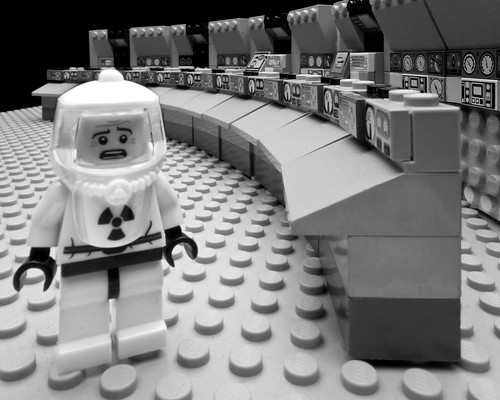
Others focused on the aftermath in the city of Prypiat, such as Juliandrius,

Angelo_S,

and Eturior.
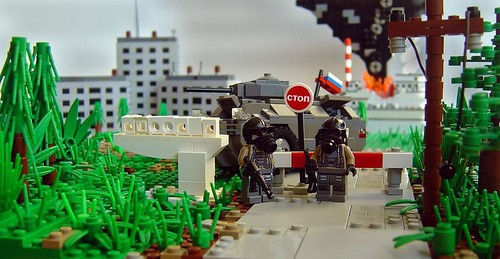
Sealclubber actually recently visited Chernobyl, with LEGO in hand.
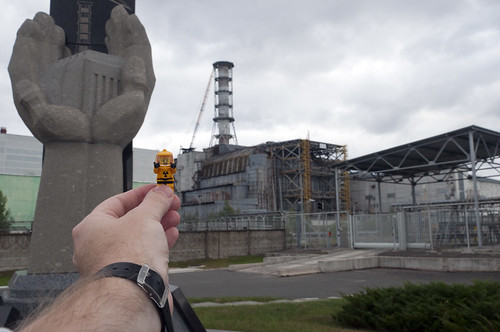
Seven years later was a much more serious nuclear event, the Chernobyl disaster. A sudden power spike in one of the reactor cores led to an explosion, spewing radioactive material into the environment. Some of this material spread over much of Europe. 28 or 31 people were killed directly by acute radiation poisoning, with another 200 or so suffering from radiation sickness. Long term effect include a rise in the incidence of thyroid cancer, with thousands affected - perhaps up to 9000 deaths will result from this over time. There was also a huge financial impact due to the cost of the cleanup, the destruction of contaminated and potentially contaminated food, and the cordoning off of a large section of land in what is now the Ukraine, including the city of Pripyat, which is now a ghost town.
Jonah Day illustrated the explosion.

Eric Constantineau illustrated the control room.

Others focused on the aftermath in the city of Prypiat, such as Juliandrius,

Angelo_S,

and Eturior.

Sealclubber actually recently visited Chernobyl, with LEGO in hand.

Monday, July 16, 2012
Nuclear power
Continuing on with our series on energy, a nuclear power plant also involves heating up water to make steam to drive turbines to make electricity. The difference here is that the heat energy comes from a nuclear chain reaction. As one unstable nucleus undergoes fission, i.e. breaks apart, it spits out subatomic particles that crash into other nuclei. These break apart and spit out more particles, that hit even more nuclei, etc etc etc. Each step of this process produces energy. If this is controlled it is a power plant, if uncontrolled it is an atomic bomb. A BrickCon 2009 attendee built this nuclear power plant. The reactor core is in the bottom left, driving a turbine in the bottom right. He should have included a little Homer Simpson fig in the control room in the upper left. I'm guessing the upper right is a cooling tower.




Friday, July 6, 2012
Fossil Fuels
Okay, I've let this slide, but I want to spend a few posts talking about energy. I noted a few days back that the bulk of electricity generation involves the heating of water to make steam, which then drives turbines. In most countries water is heated by the burning of fossil fuels (in the US this accounts for about 70% of electricity generation) such as coal. About 300 million years ago, dense forests got slowly buried underground. The process of time and pressure transformed this plant matter into what we know today as coal, so this is essentially stored and concentrated solar energy, from the ancient photosynthesis of those plants. Today we dig up this coal (here's an excellent Marion 182m Shovel used in coal mining by Redjack Ryan),

transport it, usually by train (coal car by Monteur),

and then burn the coal in a plant such as the Kingsnorth Power Station (here from Legoland Windsor).
.jpg)
BTW, the real Kingsnorth plant has been the site of several high profile protests by environmental activists. It seems that tiny little ABS activists have also been to Windsor:


transport it, usually by train (coal car by Monteur),

and then burn the coal in a plant such as the Kingsnorth Power Station (here from Legoland Windsor).
.jpg)
BTW, the real Kingsnorth plant has been the site of several high profile protests by environmental activists. It seems that tiny little ABS activists have also been to Windsor:

Subscribe to:
Posts (Atom)